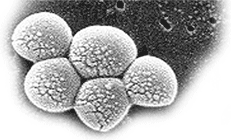Should prophylactic antibiotic bone cement be the standard?
Surgeons debated its use in THR at the Current Concepts in Joint Replacement- Winter 2003 meeting.
Deep infection following total hip replacement can be a serious and costly complication. Whether the potential for infection warrants prophylactic use of antibiotic-containing bone cement was the topic of a debate at the recent Current Concepts in Joint Replacement � Winter 2003 meeting.
Henrik Malchau, MD, PhD, in the department of orthopaedics, Sahlgrenska University Hospital, Gothenburg, Sweden, said that prophylactic use of antibiotic bone cement should be considered an emerging standard. Arlen D. Hanssen, MD, at the Mayo Clinic, Rochester, U.S.A., said he opposes its regular use.
Serious and costly
|
SOURCE: CDC/JIM BIDDLE |
To support his view, Malchau presented a study that investigated the characteristics of 1158 patients who had a revision after deep infection following total hip replacement (THR). The investigators estimated risk factors for revision and re-revision for infection in comparison with the primary population.
Data on all revisions for primary and hematogenous deep infection from 1979 to 2000 were collected from the Swedish National Hip Registry revision database. The investigators used regression analysis to compare a subgroup of 352 patients to the original population who had received THR.
Malchau said that the revised population consisted of 645 men and 513 women with a mean age at revision of 69.4 years. The patients were followed for a mean of 9.6 years. Of the 1158 revised population, 277 were stage-one revisions, 654 were stage-two procedures and 227 were permanent extractions.
�The most common bacteria found in intraoperative cultures was coagulase negative staphylococci (CNS) and S. aureus,� Malchau said. Forty percent (291 patients) tested positive for CNS and 19% (134 patients) were S. aureus positive.
�The observed increase in coagulase negative staphylococci has been observed in the hospital environment during the last decade and is probably not related to the use of antibiotic-containing bone cement.�
An interesting finding was the significant shift in the types of bacteria seen over the years, Malchau said. �We found an increase in the CNS group and a decrease in the gram-negative aerobes (Chi-square test P<.05).� The two risk factors most associated with infection upon revision were male gender (OR 1.7, CI 1.4-1.2) and the use of nonantibiotic bone cement during primary THR (OR 1.6, CI 1.2-2.0).
�Based on these findings, we support the use of antibiotic-containing bone cement and increased attention for the prevention of infection in men,� Malchau said. �Deep infection following THR is a very serious complication for the patient and a very costly phenomenon for society.�
Treatment vs. prophylaxis
Hanssen said that antibiotic bone cement for prophylaxis has been widely accepted in Europe for decades, but the U.S. Food and Drug Administration has only recently approved its use in the United States.
�It is important to distinguish between treatment and prophylaxis when using antibiotic bone cement,� he said. �Its use for treatment of existing infection is well accepted, but this indication requires a higher dosage.� It requires hand mixing and there is none commercially available, he said.
He said that companies intend to market a low-dose product (0.5 g to 1.0 g per 40 g of cement), a dosage that is not appropriate to treat an existing infection. �There is little debate about the superiority of elution kinetics from a commercially prepared product when compared with the variability that occurs with surgeon hand-mixed products.�
An important issue is whether the availability and use of commercially prepared low-dose antibiotic bone cement should be considered the standard of care for prophylaxis in large joint arthroplasty, Hanssen said.
�The primary advantage of antibiotic bone cement for prophylaxis is the further reduction of an already low rate of deep periprosthetic infection,� Hanssen said. He noted, however, that it is important to differentiate between its use in primary vs. revision patients as the risk-benefit-ratio is different. High-risk patients undergoing joint arthroplasty may �potentially benefit� from the use of antibiotic bone cement, he said.
Disadvantages, issues
Hanssen outlined several disadvantages: an increased risk of antibiotic-resistant organisms, risk of allergic reaction, potential system toxicity, and the effect that an addition of antibiotics could have on the bone cement�s mechanical properties.
The major issues are establishing the proper dose, the best antibiotic to use, the best bone cement to use, and whether it should be used routinely or only in high-risk patients, Hanssen said. �These four factors have huge implications for the approval process and the preparation of antibiotic bone cement on a commercial basis.�
Gentamicin is the most widely used and studied for this purpose, he said, but there have been reports of gentamicin-resistant organisms. �It is well known that the continuous presence of low dosages of antibiotics increases the likelihood of resistance.�
An alternative, cephalosporins, carry an increased risk of allergic reaction. �And unlike the use of systemic antibiotics, the occurrence of an allergic reaction in association with antibiotic bone cement would require further operative intervention to remove the cement and remove the prosthesis,� Hanssen said.
While the use of antibiotic bone cement could be warranted in revision cases and with high-risk patients, Hanssen said, the data on its use in primary and uncomplicated cases are retrospective and inconclusive. He said he is not willing to say that its routine use in all patients outweighs the potential disadvantages of emerging organism resistance.
Please see the print edition for more coverage of infection news.
For more information:
- Malchau H. Prophylactic use of antibiotic bone cement: An emerging standard � in the affirmative. Hanssen AD. Prophylactic use of antibiotic bone cement: An emerging standard � in opposition. Both presented at Current Concepts in Joint Replacement � Winter 2003 meeting. Dec. 10-13, 2003. Orlando, U.S.A.

